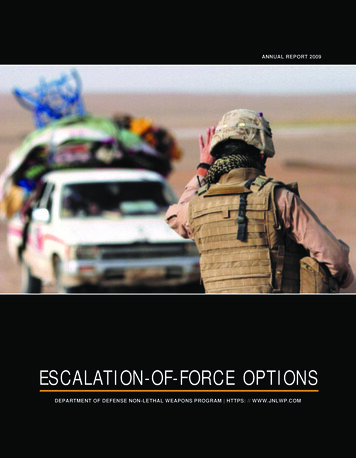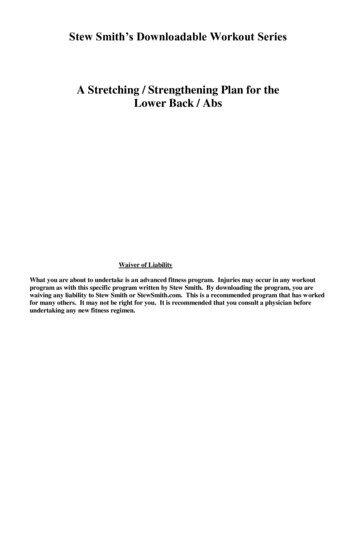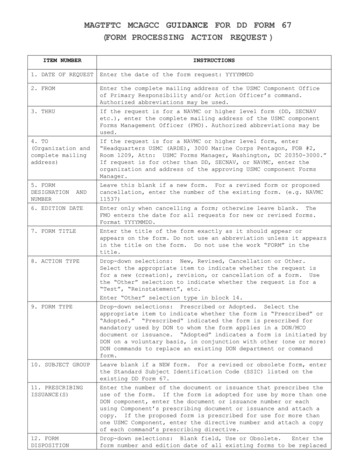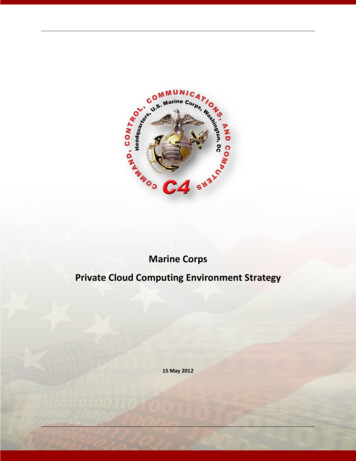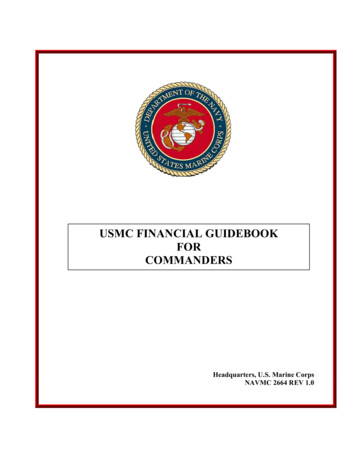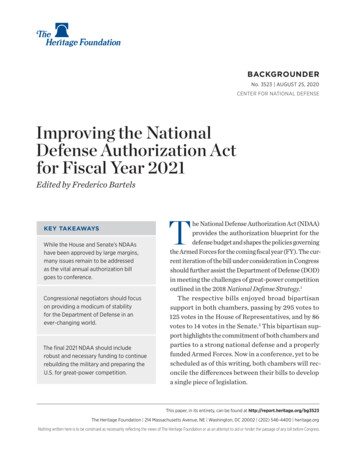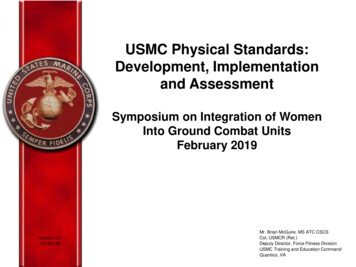
Transcription
USMC Physical Standards:Development, Implementationand AssessmentSymposium on Integration of WomenInto Ground Combat UnitsFebruary 2019Version 1.020190130Mr. Brian McGuire. MS ATC CSCSCol, USMCR (Ret.)Deputy Director, Force Fitness DivisionUSMC Training and Education CommandQuantico, VA
Agenda Purpose / Endstate / BLUF Physical Screening and Testing Background andFramework 2016-2018 Data1
Purpose / End state / BLUF Purpose: TECOM provides Symposium on Integration ofWomen Into Ground Combat Units attendees an overviewand update on the USMC MOS Specific Physical Standards(MSPS). End state: Symposium attendees understands USMC MOSphysical screening methodology, trends, and way ahead. BLUF: MSPS and enhanced physical screening give areasonable assurance Marines have the physical capacity toperform in physically demanding MOSs and have enabledtalent management efforts.2
Taskings for Gender NeutralStandards Development3
Background NDAA FY15: “Secretaries of the military departments should developgender-neutral occupational standards that accurately predictperformance of actual, regular, and recurring duties of a military occupation;and are applied equitably to measure individual capabilities .validatedoccupational standards will be in use by Sept 30th, 2015 at MOS schools.” MOS standards have been clarified, refined, and validated for the followingspecified MOSs based on the physical skills required:Infantry, Artillery, Tanks, Amphibious Vehicles, Low Altitude Air Defense, CombatEngineers and Ground Ordnance Maintenance MSPS are gender-neutral, operationally relevant, and occupation specific: Comply with DoD guidance and related statutes Maintain combat readiness Better capitalize on the full potential of every Marine Sustain the quality of the Force going forwardInitial effort focused only on closed MOSs. Laws require MSPS for ALL MOSs.4
Initial Questions from Leadership June 2012 What is the correlation of the PFT and CFT to physically demanding tasksexpected of a Marine operating as part of a Ground Combat Element? Sept 2012 What is the correlation of the PFT and CFT to physically demanding tasksin the Closed MOSs? Can the PFT and CFT be used as a screen for those who want to go intoa physically demanding MOS?5
Physical Fitness Test (PFT)OverviewThe PFT is designed to measure general fitness. It is specifically designed to test the capacity of theupper body, midsection, and lower body, as well as efficiency of the cardiovascular and respiratorysystem. It is not intended to assess mission or occupationally specific fitness demands. Est. 1972.Events Hybrid Pull-up/ Push-up test (Max points for pushups is 70 pts) Abdominal Crunch 3 Mile Run /5,000 meter (5K) rowPFT Administration: Conducted annually for all Marines regardless of age, gender, grade or duty assignment between 1January and 31 December Events conducted while wearing green-on-green T-shirt, shorts, and running shoes. The green-ongreen sweat suit/ running suit with watch cap and gloves may be worn. Marines aged 46 years of age and older have the option of the 5K Row as an alternative event forthe three mile run. Marines 45 and under may row in lieu of running if recommended by a healthcare provider and approved by their Commanding Officer. Gender-neutral events; gender and age-normed scoring Reported on personnel evaluations PFT performance linked to body composition program decisions6
Combat Fitness Test (CFT)OverviewThe CFT, as a complement to the Physical Fitness Test, measures functional elements of fitnessthrough the execution of a series of events that emphasizes our ethos of “Every Marine a rifleman.”Est. 2009.Events Movement to Contact (880 yd run) Ammo Lift (two minute repetitive lift of 30 lb. ammo can from shoulder to overhead) Maneuver Under Fire (MANUF) (300 yd shuttle run that includes crawls, sprints, fireman’s carry,simulated grenade throw, and ammo can carry)CFT Administration: Conducted annually for all Marines regardless of age, gender, grade or duty assignment between 1July and 31 December Events conducted while wearing the seasonal utility uniform and boots No less than five minutes rest between events On MANUF, individuals paired based on their weight (within 10lb.) for fireman’s carry portion Gender-neutral events; gender and age-normed scoring Reported on personnel evaluations CFT performance linked to body composition program decisions7
Assessment of GCE Physical PerformanceStandards Purpose of Study: To correlate PFT and CFT scores to performances on selected GCE tasks(HMG MK19 Lift; CASEVAC; March under Load) ( 2000 males, 400 females) Naval Health Research Center (NHRC) Report CFT performances (by-event) are good predictors of performance to GCE tasks. Thecorrelation is stronger with females than with males. For males - performance on the PFT run & pull-up events are good predictors ofperformance on GCE tasks. For females - the PFT run event is a good predictor of some GCE tasks – the flexed-armhang is not. Males generally outperformed females on GCE tasks, but more physically fit femalesoutperformed less fit males on some events (e.g., 34% of females outperformed slowestmale on CASEVAC ). Study limitations include: Most of sample 18-23 y/o (not physically mature, especiallystrength), lack of training on MK-19 lift. Recommendations: CMC decision to direct development and testing of a Gender Neutral PFT and CFT thatdoubles as tests of generalized fitness and serves as GCE classification system Further research is necessary to correlate the gender neutral tests to closed MOS tasks8
Closed MOS Testing Background Validated standards enabled the development of a Test Battery toassess physical performance tasks Tests linked to existing physical standards Replicated physical movements and weight requirements Subject Matter Expert and incumbent agreement 409 males, 379 females Active duty, Permanent personnel (non-recruits), fit for full duty Marine Corps Recruit Depot Parris Island SC School of Infantry East, Camp Lejeune NC The Basic School, Quantico VA Naval Health Research Center (NHRC) analyzed Test Batteryresults and correlated these to PFT and CFT events9
Physical Tasks to Test Event RelationshipsPROXYGROUND TOOVERHEADGROUND TOKNUCKLE HEIGHTCLOSED MOS PHYSICAL TASKS / ACTION / WEIGHTMOS / SOURCE DOCUMENTSINSTALL/REMOVE/LOAD UGWS (MK19, M2 50 CAL) @ 60-84 LBSLIFT INTERNAL INTAKE PLENUM COVER @ 50 LBSOPEN INTAKE PLENUMS (2-MAN) – 110 LBS OF FORCE @ 55 LBS EACHOPEN EXHAUST PLENUMS (3-MAN) - 310 LBS OF FORCE TO LIFT 600 LBS @ 103 LBS EACHUNLOAD STUCK ROUND @ 100 LBSOPEN M1A1 TC & LDR HATCHES @ 70 LBSSTOW ORDNANCE - CARRY M1A1 ROUND 50M @ 55 LBSTRACK/RANGE AERIAL TARGET – SHOULDER STINGER OR TRACKER HEAD TRAINER @ 53 LBSASSIST EVAC OF PERSONNEL: MARINE BELOW TURRET ‘PUSHING’ CREWMAN UP/OUT) @ 115 LBS- MOS 1833: NAVMC 3500.2A AAV T&RAAV CREWMAN POI (CID# M10AHY3)- MOS 1812: NAVMC 3500.1A TANK T&RTANK CREWMAN POI (CID# A03TBM2)- MOS 7212, 7204: NAVMC 3500.57A LAADT&R; LAAD GUNNER POI (CID# A042141);LAAD OFFICER POI (CID# A04ANS1)LIFT/INSTALL 300 LB TOW BAR (3-MAN) @ 100 LBS EACHASSIST EVAC OF PERSONNEL: MARINE OUTSIDE TURRET ‘LIFTING’ CREWMAN UP/OUT) @ 115 LBSREPAIR TRACK BLOCK (AAV) @ 35 LBSREPAIR ROAD WHEEL @ 84 LBSREPAIR SUSPENSION (2-MAN) @ 100 LBS EACHREPAIR STARTER (1-MAN IN CONFINED SPACE) @ 50 LBSREPLACE TRACK BLOCK (M1A1) @ 60 LBSLIFT/MOVE TOOL BOX / TEST EQUIPMENT @ 60 LBSLOAD M1A1 BATTTERIES @ 70 LBSREMOVE/INSTALL M1A1 GENERATOR @70 LBSLIFT/LOWER RTNB AND REMOVE HULL TURRET SLIP RING (M1A1) @ 100 LBSREMOVE M1A1 TORSION BAR AND REPLACE ROAD WHEEL @ 100 LBSLOAD/UNLOAD LAAD MANPAD VEHICLE - (4) STINGER CONTAINERS (120 LBS EA) (2-MAN) @ 60 LBSLOAD /UNLOAD (4) STINGER WPN CONTAINERS – MOVE 50M & EMPLACE 40M APART @ 60 LBS EACHMOVE/CARRY 213 LB NITROGEN BOTTLE (2-MAN) @ 105 LBS EACHLIFT (LAV) 400 LB STRUT ASSEMBLY: (3-MAN) @ 135 LBS EACHLIFT LAV CONTROL ARM @ 70 LBSREMOVE/INSTALL LAV COMPONENTS - M242 GUN : 59 LB FEEDER, 90 LB RECEIVER, 95 LB BARRELREMOVE/INSTALL (160 LB) LAV TIRE (2-MAN) @ 80 LBS EACH- MOS 1833: NAVMC 3500.2A AAV T&RAAV CREWMAN POI (CID# M10AHY3)- MOS 1812: NAVMC 3500.1A TANK T&RTANK CREWMAN POI (CID# A03TBM2)- MOSs 2131, 2146: NAVMC 3500.33AGROUND ORD MAINT T&R; ARTILLERY TECHPOI (CID# A140806); TANK TECHNICIAN POI(CID# A03GBN2)-MOS 2147: NAVMC 3500.33A GROUND ORDMAINT T&R; LAV REPAIRMAN POI (CID#A14GBD6)- MOS 7212, 7204: NAVMC 3500.57A LAADT&R; LAAD GUNNER POI (CID# A042141);LAAD OFFICER POI (CID# A04ANS1)155MM LIFT/CARRYSTOW ORDNANCE/LOAD HOWITZER: LIFT/CARRY 155MM RD (@ 95 LBS) 50M 2 MINLIFT & CARRY 100 LB GENERAL MECHANICS TOOLBOX @ 100 LBS- MOSs 0811: NAVMV 3500.67 ARTILLERYT&R; ARTILLERY CANNONEER POI (CID#A200821)- MOS 2131: NAVMC 3500.33A GROUND ORDMAINT T&R; POI (CID# A140806)120MM LIFT/LOADGUNNERY SKILLS TEST: LOAD M1A1 ROUNDS FOR TIME - LIFT/TURN/LOAD(STACK) 5X RDS 35 SEC- MOS 1812, 1802: NAVMC 3500.1A, TANKCREW T&R; NAVMC 3500.2A, TANK OFFICERT&R; POIs (CID# A03TBM2, CID# A03T612)EXECUTE LOWERLEVEL ENTRYNEGOTIATE OBSTACLE COURSE WALLMOS 0300, 0311: NAVMC3500.44A, INF T&R;POI (CID# M030314, M100312)10
Closed MOS Test Battery1. Ground to knuckle height Lift (lower body movement, anaerobic, strength) 1 rep max progressing ladder (60, 70, 80, 95, 115, 135 lbs) Little variance in performance2. Ground to Overhead Lift (lower/upper body movement, anaerobic, strength) 1 rep max progressing ladder (70, 80, 95, 115 lbs and 6x65 lbs) High variance among participants3. 120mm Tank Round Lift & Load (lower/upper body movement, anaerobic, strength/endurance) Lift and load five (5) 120mm projectiles (@ 55lbs) 35 sec High variance among participants4. 155mm Artillery Round Lift & Carry (lower/upper body movement, anaerobic,strength/ endurance) Pick up and carry a 155mm projectile (@95lbs) 50m 2 minutes wearing 40lbfighting load Moderate variance among participants5. Execute Lower-Level Entry (upper body movement, anaerobic, strength) Negotiate Obstacle Course 7’ Wall with 20” box assist wearing 40lb fighting load Moderate variance among participants11
Overall Closed MOS Testing Score Used to quantify a Marine’s performance across the spectrum of test events. Similar to an overallPFT or CFT score.More variability in the overall score allows for more meaningful correlations to PFT and CFTcomponent tests.The overall Closed MOS Testing score is a simple percentage of the pass/fail proxy tasks thatwere successfully completed. Though there were 5 overall tests, there were a total of 14 pass/failelements: 6 for the Ground to Knuckle Height: 135 lbs, 115 lbs, 95 lbs, 80 lbs, 70 lbs, 60 lbs 5 for the Ground to Overhead: 115 lbs, 95 lbs, 80 lbs, 70 lbs, 65 lbs for 6 reps 1 each for the Tank loading drill, 155 mm round carry and the wall obstacle Example 1: Marine passed all the events except the heaviest two ground to overhead lifts (115and 95 lbs) Pass 1, Fail 0: Ground to Knuckle Height (1 1 1 1 1 1) Ground to Overhead: (0 0 1 1 1) Tank Loading (1) 155mmrd carry (1) wall obstacle (1) 12/14 .86 This score (.86) is correlated to all the PFT and CFT events Example 2: Marine passed all the events but failed all ground to overhead lifts and the wallobstacle: Ground to Knuckle Height (1 1 1 1 1 1) Ground to Overhead (0 0 0 0 0) Tank Loading (1) 155mmrd carry (1) wall obstacle (0) 8/14 .57 This score (.57) is correlated to all the PFT and CFT events Summary: Since the overall Closed MOS Testing Score quantifies a Marine’s performance acrossall tasks and adds variability to the range of scores, correlations between this score and PFT /CFT events should have equal or greater consideration than correlations of individual closed MOSevents to PFT / CFT events.12
Correlation of PFT and CFT Events to ClosedMOS TasksPFT / CFT Components Correlation1to Overall Closed-MOS PhysicalTasks Test Scores 2, 3PFTPull Ups0.75Crunches0.383-mile Run-0.61Flexed Arm Hang0.23VeryStrong* .81Strong.49 - .80Moderate.25 - .48Weak.00 - .24CFTMovement to Contact-0.71Ammo Lift0.76Maneuver Under Fire-0.77*Pett, M. A. (1997). Nonparametric Statistics for Health CareResearch: Statistics for Small Samples and UnusualDistributions. Thousand Oaks, CA: Sage Publications, Inc.Note1: Spearman’s ρ is a non-parametric version of the Pearsoncorrelation, which does not require the assumption of normality,and can partially correct for range restriction.Note 2: Overall closed-MOS physical tasks test scores were basedon the percentage of 14 pass-fail tasks completed successfully onthe Proxy Test Battery.Note 3: Correlation values range from -1 to 1 with weakestcorrelations occurring at values near zero.13
Summary of GCE and Closed MOS testing Performance on most USMC PFT and CFT events serveas a sound basis for making valid inferences about aMarine’s capability to perform physically demandingMilitary Occupational Specialty tasks.14
Recruit TrainingRecruitingMOS SchoolOPFORMOS QualificationContinuationMOS ClassificationInitial ScreeningGenderNeutralGenderNormedInitial Strength Testfor physicallydemanding PEFsMOS ClassificationStandards forspecified MOSsInitial assessment ofMOS Specific PhysicalStandardsContinuation of MOSSpecific PhysicalStandardsIST for all other MOSsIST for all recruitsPFT/CFT for all otherMOSsPFT/CFT for allMarinesPFT/CFT for allMarinesEnlistmentTransformationMOS TrainingOPFOR ServiceIndirect TestingIncreasing Physical RigorPhysical Standards Screening and TestingDirect Testing15
MSPS Development 1000 PhysicalT&Revents fromspecified MOSsFocused on what SMEs viewViewed throughthe Joint Forcible Entry as Most Critical based onFrequency, Duration,Operations LensIntensity and Importance 23 OccupationSpecific PhysicalStandards across29 MOSs525 CandidateT&R EventsIntegratedAdvocateMOS SpecificRepresentativePhysical Research AnalysisInputsStandardsDevelopmentWho were the SMEs who provided inputs to the MSPS development process?– A mix of over 600 officers, SNCOs and NCOs from TECOM (task analysts,schoolhouse instructors, OPSOs/chiefs) and the Operating Forces (Bn COs, XOs,OPSOs/Chiefs, Marines currently serving in the specified MOSs) with an averageof 6.1 years MOS time– SMEs involved throughout process from Sept 14-Jul 15 Were the Advocates involved? What levels?– Yes; in every phase of MSPS development at the 0-6 level and higher What other agencies were involved?– Internal: Manpower, Office of General Counsel, USMC Force Innovation Office– External: Naval Health Research Center, RAND, Government Accounting Office,University of Pittsburgh, Secretary of Defense16
MOS Specific Physical StandardsDevelopment FrameworkPhase1. MOS Physical Task Identification2. Task Criticality Assessment (TCA)3. Task Observation4. MOS Specific Physical Standard Event Recommendations & Selection5.a. MOS Specific Physical Standards Development5.b. MOS Specific Physical Standards Testing5.c. MOS Specific Physical Standards Refinement (Informed by allanalysis of previous TECOM research along with LOE 2, and LOE 3 data)17
Task Criticality AssessmentTask: 0313-M242-1007Perform immediate actionprocedures for an M24225mm automatic gunTask: 0313-M242-1002:Load the M242 25mmautomatic gunMethodology:Criteria(weight)*Score Likert scaleclassification x (criteriaweight)Score Likert scaleclassification x (criteriaweight) Frequency(.10)1 X (.10) .12 X (.10) .2Duration(.20)2 X (.20) .42 X (.20) .4Intensity(.30)4 X (.30) 1.24 X (.30) 1.2Importance(.40)3 X (.40) 1.25 X (.40) 2CompositeScore2.93.8 Criteria and Weights recommended by TECOM, approvedby Advocates5.0 is max possible score on each taskRespondents blinded to criteria weight andby-task composite scoreProvides a means to objectify large amounts of subjectivedata*Criterion and Weights will require CG TECOM with Advocate concurrenceLikertScaleFrequency (10%)Duration (20%)Intensity (30%)Importance (40%)511-20 or more times a day45 minutes to greaterthan an hour at a timeMost intense of all tasks(maximum anaerobic,aerobic or strength effort)Most important of alltasks (If the Marine isunable to do this theywill endanger livesand the mission)41-10 times a day21-45 minutes at a timeMore intense than mosttasksMore important thanmost tasks3At least once a day11-20 minutes at a timeVery intenseVery Important23 or more times a week6-10 minutes at a timeMore intenseMore Important1Weekly or less frequently1-5 minutes at a timeIntenseImportant*Intensity; Level of anaerobic, aerobic or strength effort necessary to complete the task** Importance: Describes how necessary completion of the physical task is to the overall missionExamples only18
MSPS DevelopmentStandards recognize that the physical capability of today’s Force is sufficientto meet mission demands Testing of over 1,000 Marines from I MEF in May 2015 served as the basisfor MOS specific physical standards recommendations Statistical analysis of task performance Fastest, Slowest, Average and Standard Deviation Analysis performed with and without outliers Timed event distributions approximated normality but did not yieldconsistent results across all tasks (eliminated too many Marines onsome tasks) Naval Health Research Center supported study design, data collectionand development of standards methodology19
MSPS Development What they are: A means for reasonable assurance of satisfactory physical performancein an MOS Derived from critical and physically demanding MOS T&R tasks Pass/fail requirements to verify & sustain key physical abilities Based on direct individual tasks & surrogate performance for criticalcrew tasks Easily administered within existing Entry Level Training (ELT) programsof instruction (POIs), with remediation as necessary What they are not: An assessment of procedural proficiency or fine motor skills A pre-requisite for entering an MOS school20
MSPS Execution MSPS are administered at various points in Programs of Instructionconcurrent with when specific T&R events are conducted MSPS are not administered like a final exam or culminating event Recycle / Reclassification policy Marines are recycled for failing a single MSPS 3x Marines are reclassified for failing a single MSPS 6x21
IST Standards for Specified MOSsRecruitingRecruitTrainingMOSSchoolOPFORIST StandardsEventPull-ups1.5 mile runCrunchesAmmo LiftTime/Reps313 mins 30 secs4445 The Gender Neutral IST with the standards given in the above table mustbe met by all enlistees seeking the following MOSs:Infantry, Artillery, Tanks, Amphibious Vehicles, Combat Engineers, LowAltitude Air Defense, and Ground Ordnance Maintenance IST (gender normed and gender neutral) are administered at RecruitingStationsStandards are based on 2013 research done in collaboration with the NavalHealth Research Center on performance of combat related tasks correlatedwith PFT and CFT events 22
MOS Classification S Classification StandardsEventPull-ups3 mile runMANUFMTCAmmo LiftTime/Reps624:513 mins 12 secs3 mins 26 secs60 The MOS Classification Standards (MCSs) above must be met by allpersonnel seeking classification in the following MOSs:Infantry, Artillery, Tanks, Amphibious Vehicles, Combat Engineers, LowAltitude Air Defense, and Ground Ordnance Maintenance Standards must be met at the MCRDs (recruits) or The Basic School (officers)and are based on final PFT /CFTStandards for pullups, MANUF, MTC and Ammo lift based on Ground CombatElement Integrated Task Force graduatesRun standard based on PFT data of I MEF units during May 2015 MOSstandards testing 23
MCS Event Breakdown for MCRDsRecruiting1 Apr 2016 - 31 Dec 2018RecruitTrainingMOSSchoolOPFOR(1 Apr 2016 was the first MCRD graduation date with MCS tested students)BLUF: MCRDs have an overall 95.7% MCS pass rate (30,161 tested, 1,294 failures)MCRDPI: 94.6% pass rate* (15,108 tested, 818 failures)MCRDSD: 97% pass rate* (All Males- 15,053 tested, 476 failures)FailuresMales: 95.5% pass rate* (14,852 tested, 674 failures)MANUF:49Pull-ups: 1293-mile run: 160 **MTC:145 **ACL:34FailuresMANUF:Pull-ups:3-mile run:MTC:ACL:117142315 **15624Male MCS Pass Rate based on MCRD Graduation DateFemales: 56.3% pass rate* (256 tested, 144 failures)FailuresMANUF:Pull-ups:3-mile run:MTC:ACL:92**667392 **15100%98%96%94%92%96.3% 95.7% 96.2% 96.0% 96.7% 96.5% 96.2% 95.7% 96.3% 95.8% 95.8%3rd Qtr 4th Qtr 1st Qtr 2nd Qtr 3rd Qtr 4th Qtr 1st Qtr 2nd Qtr 3rd Qtr 4th Qtr 1st QtrFY16 FY16 FY17 FY17 FY17 FY17 FY18 FY18 FY18 FY18 FY19Female MCS Pass Rate based on MCRD Graduation Date*Several Recruits, at both Depots, failed multiple events**Most commonly failed MCS in red80%60%40%20%0%73.7% 57.6% 61.1% 62.0%56.3%33.3%11.1%18.2% 23.8%38.5% 37.0%3rd Qtr 4th Qtr 1st Qtr 2nd 3rd Qtr 4th Qtr 1st Qtr 2nd 3rd Qtr 4th Qtr 1st QtrFY16 FY16 FY17 Qtr FY17 FY17 FY18 Qtr FY18 FY18 FY19FY18FY17MOS Classification StandardsEventPull-ups3 mile runMANUFMTCAmmo LiftTime/Reps624 mins 51 secs3 mins 12 secs3 mins 26 secs6024
Total MSPS Reclassification Data from ClassesGraduating 01 Oct 2015 – 31 Dec 2018RecruitingRecruitTrainingMOSSchoolOPFOR99.5% - Passed MSPS Requirements Students Tested: 34,267Reclassified: 162 Reclassifications by Gender:Passed: 33,956 (99.6%) Reclassified: 143MalesFemalesPassed: 158 (89.3%)Reclassified: 19 MOSs with Reclassifications: 03xx 122x males, 5x females 08xx12x males, 2x females 13719x females 03213x males 21462x females 21472x males 18122x males 18331x male, 1x female 21311x males MSPS events failed resulting in Reclassification*: Cross a Wall93x males, 5x females MK-19 Lift26x males, 10x females Vehicle CASEVAC17x males, 3x females Ground CASEVAC10x males, 5x females HESCO Lift10x femalesWeight / Height Data 20 km Hike7x males Carry Artillery Rounds 4x malesMSPS Reclassifications:MSPS 5 lbs, height: 69 in 2k Yard Fin2x malesM:136 lbs, 66 inM:165 lbs, 69 in 20 km Ruck Run1x maleF: 123 lbs, 63 inF: 139 lbs, 65 in* Those who fail, commonly fail multiple events.(30 lbs heavier and 4 inches taller)Takeaways: Minimal impact to MOS production or T2P2 thus far MOS Classification Standards implemented Apr 2016 in recruit training Reclassified personnel are generally shorter and lighter than those who passed but not the shortestand the lightest who have tested and passed. Minimal injuries25
MSPS Pass Rate01 Oct 2015 – 31 May 2018RecruitingRecruitTrainingMOSSchoolOPFOR26
Ground SchoolOPFORObserved 2.5th PercentileStandardMaleFemaleTime (secs)Standard 54 seconds2.5th Percentile 51 Seconds2.5th Percentile 6% faster than Standard27
Non-Combat Arms Assignmentto Load Bearing ia for Assignment of Non-Combat Arms Marines toLoad Bearing Units Event3 mile runMTCAmmo LiftMANUFTime/Reps28:003:40603:17Standards are based on analysis of all male non-combat arms MOSs*across the force which are assignable to previously closed GCE units.*MOSs:: 01xx, 02xx, 04xx, 06XX, 2100, 2111, 2171, 2311, 2401, 2844, 2862, 30xx, 3381, 3521,3529, 3531, 3537, 4100, 5702, 5711, 7502, 8404, 8421, 8425, 8432, 8999, 995428
Phase II Prioritized MOS ListAdvocate MOS #MOS DescriptionRank(s)Helicopter Crew Chief, CH-536173Pvt - GySgtHelicopter Crew Chief, UH-1N/Y6174Pvt - GySgtTiltrotor Crew Chief, MV-226176Pvt - GySgtAviation Ordnance Trainee6511N/AAviation Ordnance Technician6531Pvt - SSgtDC AVNAviation Ordnance Systems Technician6541Pvt - SSgtAviation Ordnance Chief6591GySgt - MGySgt6091 Aircraft Intermediate Level Structures Mechanic-TraineePvt - GySgtAircraft Intermediate Level Structures Mechanic6092Pvt - GySgtAircraft Rescue and Firefighting Specialist7051Pvt - MGySgtEOD Technician2336Sgt-MGySgtEOD Officer2305WO-CWO5/Capt-LtColEngineer Equipment Mechanic1341Pvt-SSgtDC I&LEngineer Equipment Operator1345Pvt-SSgtSmall Craft Mechanic1342LCpl-SSgtMetal Worker1316Pvt-SSgtMilitary Police5811PVT to MGYSGTMilitary Police Officer58032ndLt to LtColMilitary Working Dog HandlerPVT to MSGTDC PP&O 5812Special Reaction Team (SRT) Member5816CPL to GYSGTCorrectional Specialist5831PVT to MGYSGTCorrections Officer5804WO to CWO529
Arthur Schopenauer“All truth passes through three stages:- First, it is ridiculed.- Second, it is violently opposed.- Third, it is accepted as being self-evident.”1788 - 186030
Leadership FeedbackBrigadier General George Smith, Commanding General Ground CombatElement Integrated Task Force, Letter to Commandant, 2015:"This is perhaps the single-most important result of this almost three yearprocess. Moving forward, the Marine Corps in general and the Ground CombatElement of our Marine Air Ground Task Forces in particular, will be morecapable as a result of more clearly defined individual performance standardsthat will ensure that Marines are assigned to MOSs for which they are best andmost fully qualified.“General Robert Neller, Commandant of the Marine Corps, Marine CorpsGazette, 2018:“Of all the things that have changed in our Corps the most significant is theestablishment of individual MOS physical standards. These standards are nowcodified for each MOS in their respective Training and Readiness Manuals.”31
ss@usmc.milwww.fitness.marines.mil32
MSPS (1 of 5)Task NameGroundCASEVACMK-19 LiftApplicable MOS0302, 0303, 0300, 0313,0321, 0802, 0811, 0842,0844, 0847, 0861, 1302,1371, 1802, 1803, 1812,1833, 2131, 2141, 2146,2147, 7204, 72120302, 0303, 0300, 0313,0321, 0802, 0811, 0842,0844, 0847, 0861, 1302,1371, 1802, 1803, 1812,1833, 2131, 2141, 2146,2147, 7204, 7212Cross a Wall0302, 0311, 0331, 0341,0351, 0352, 032120KM Hike0311, 0331, 0341, 0351,0352RecruitingRecruitTrainingMOSSchoolTask DescriptionT&R EventsMinimumStandardWhile wearing a fighting load and carrying a servicerifle, sprint 25 meters to a simulated casualty (214 lbs),evacuate the casualty 25 metersINF-MAN-4208, 0300-MED1001,RECN-MED-100254 Sec *0300-TVEH-1001, RECN-WPNSLift the MK-19 heavy machinegun from the ground to2043, 1803-GNRY-1006, 1833overheadGNRY-1005OPFORPass/Fail **Scale a 56” wall unassisted while wearing the fightingload and carrying a service rifle0300-MOUT-100130 Sec *March 20 km with MOS specific weapons & equipmentwhile wearing the assault load0300-COND-10015 Hours **New Event with Time Standard** New Pass/Fail Event*** Existing Event & Standard33
MSPS (2 of 5)RecruitingRecruitTrainingMOSSchoolOPFORTask NameApplicable MOSTask DescriptionT&R EventsMinimumStandard0311 Rush300M toObjective0302, 0311While wearing a fighting load and carrying a service rifle,run/rush for 300 meters through a course with an agility network0300-PAT-10053Min, 56Sec *0300-PAT-10052Min, 11Sec *0341: 0300-PAT1Min, 45Sec *0300-PAT-10051Min, 40Sec *0300-PAT-10051Min, 43Sec *0331 Rush200M as MGAmmo Bearer0341 Rush200M with60MM Mortar0351 Rush200M withSMAW0352 Rush200M withJavelin0331034103510352While wearing a fighting load and carrying a service rifle, Sparebarrel bag and two ammo cans, run/rush for 200 meters througha course with an agility networkWhile wearing a fighting load and carrying a service rifle, and a60mm mortar in hand-held mode, run/rush for 200 metersthrough a course with an agility networkWhile wearing a fighting load and carrying a service rifle, and aSMAW, run/rush for 200 meters through a course with an agilitynetworkWhile wearing a fighting load and carrying a service rifle, and aJavelin, run/rush for 200 meters through a course with an agilitynetwork*New Event with Time Standard** New Pass/Fail Event*** Existing Event & Standard34
MSPS (3 of 5)Task Name13xx Rush 150Mwith APOBSApplicable MOS1302, 1371VehicleCASEVAC0303, 0313, 2146, 2147,0802, 0811, 0842, 0844,0847, 0861, 2131, 1372,1802, 1812, 1803, 1833,2146, 2141Hesco Lift 100lbSurrogate1302, 1371RecruitingRecruitTrainingMOSSchoolOPFORTask DescriptionT&R EventsMinimumStandardWhile wearing a fighting load and carrying a servicerifle, with an APOBS pack assembly, run/rush 150meters through a course with a agility network1302-MOBL-1005, 1371MOBL-1003,1Min, 12Sec *1802-GNRY-1011 , 1812GNRY-1008, 0313-MOBL1004, 0811-MED-1030, 1372Ground to overhead lift of an Olympic bar with totalMOBL-1007, 1803-GNRYweight of 115 lbs. (Surrogate)1021, 1833-GNRY-1017, 2131MED-1001, 2141-MED-1001,2146-MED-1001, 2147-MED1001Ground to overhead lift of Olympic bar with total weightof 100 lbs. (Surrogate)1302-CMOB-1001, 1371SURV-1001Towbar 150lbSurrogate1802-VOPS-1009, 1803-VOPS0303, 0307, 0313, 2147, Deadlift & hold Olympic bar with total weight of 150 lbs. 1007, 1812-VOPS-1008, 1833at knuckle height for 30 seconds (Surrogate)VOPS-1014, 0313-MOBL-1005,1802, 1812, 2146, 1803,2141-VOPS-1002, 2143-VOPS1833, 21411002, 2147-VOPS-1002Breach a Door0302, 0351, 1302, 1371While wearing a fighting load and carrying a servicerifle, breach a door with a battering ram*New Event with Time Standard** New Pass/Fail Event*** Existing Event & Standard0351-DEMO-1009, 1302MOBL-1006,1371-MOBL-1001Pass/Fail **Pass/Fail **Pass/Fail **14Sec *35
MSPS (4 of 5)Task NameApplicable MOSTask T&R EventsMinimumStandardRECN-RAID-100144Sec *0313-WPNS-1001, 2147WPNS-10012Min, 24Sec ***Recon Rush100M withBreachingEquipment0307, 0321Disassemble /ReassembleM242 25MMGun0303, 0313, 2147Disassemble/Assemble the M242 25mm automatic gunby manipulating the receiver and feederRecon 20KMRuck Run0307, 0321Run 20 km with a service rifle while wearing thereconnaissance loadRECN-COND-10033 Hours ***Recon 2K yardFin0307, 0321Fin 2,000 yards with a service rifle while wearing &pulling/pushing the reconnaissance loadRECN-AMPH-10101 Hour ***0307, 0321While wearing the reconnaissance load and carrying aservice rifle, climb a caving ladder to a 10 meter platformRECN-SPIE-10182Min, 27Sec *Climb CavingLadderWhile
assist evac of personnel: marine below turret 'pushing' crewman up/out) @ 115 lbs - mos 1833: navmc 3500.2a aav t&r. aav crewmanpoi (cid# m10ahy3) - mos 1812: navmc 3500.1a tank t&r. tank crewmanpoi (cid# a03tbm2) - mos 7212, 7204: navmc 3500.57a laad t&r; laad gunner poi (cid# a042141); laad officer poi (cid# a04ans1) ground to knuckle height
